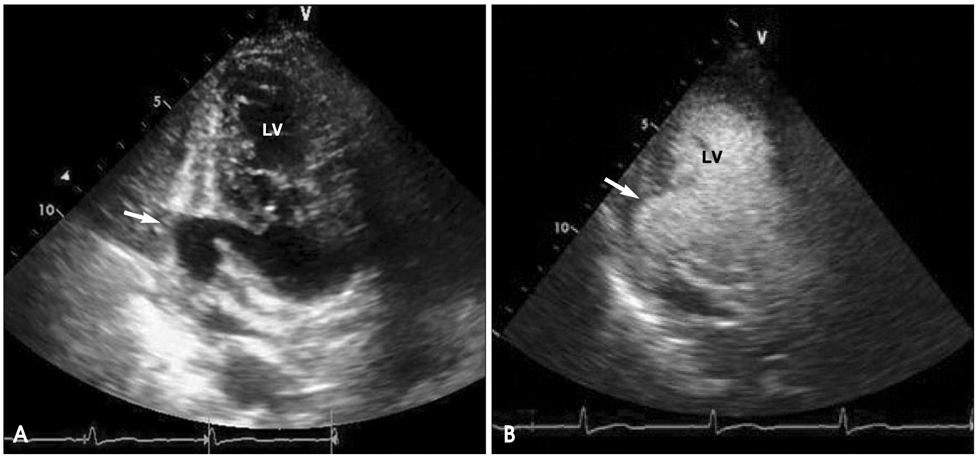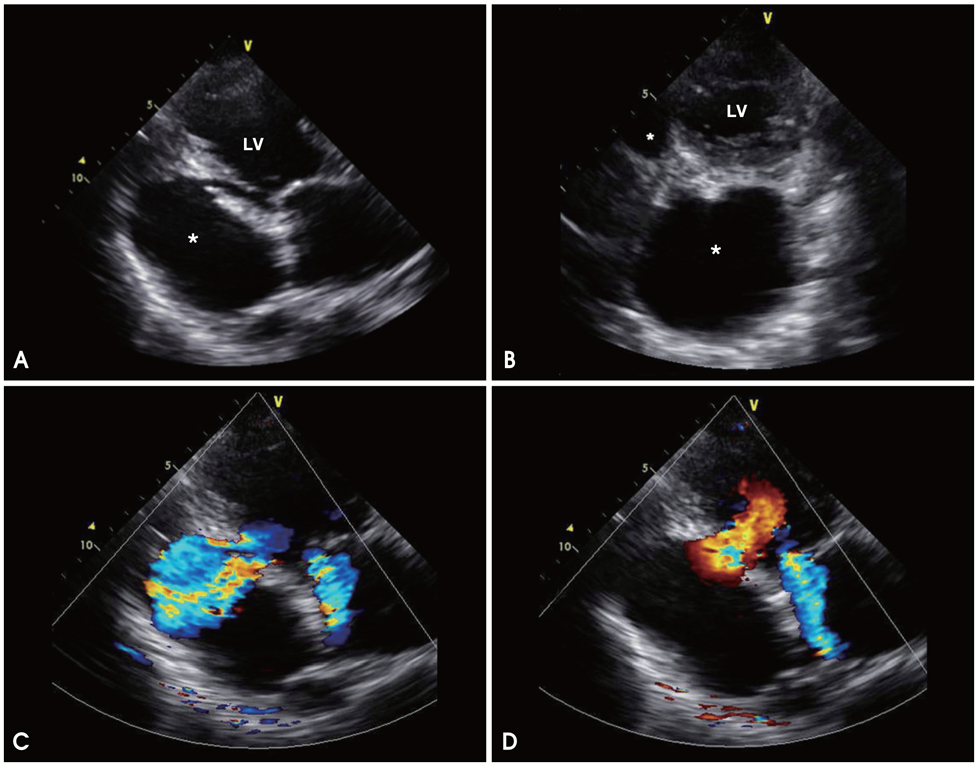J Cardiovasc Ultrasound.
2010 Dec;18(4):161-164. 10.4250/jcu.2010.18.4.161.
Progression of Left Ventricular Pseudoaneurysm after an Acute Myocardial Infarction
- Affiliations
-
- 1Division of Cardiology, Department of Internal Medicine, Korea University College of Medicine, Seoul, Korea. smparkmd@korea.ac.kr
- KMID: 2177321
- DOI: http://doi.org/10.4250/jcu.2010.18.4.161
Abstract
- Left ventricular (LV) pseudoaneurysms rarely occur, but are detected more often with the development of new diagnostic tools. Since LV pseudoaneurysms are life-threatening, early surgical intervention is recommended. This report describes an 87-year-old woman with heart failure and a large LV pseudoaneurysm which progressed from a small LV pseudoaneurysm after an acute myocardial infarction over a 1-year period.
MeSH Terms
Figure
Reference
-
1. Frances C, Romero A, Grady D. Left Ventricular Pseudoaneurysm. J Am Coll Cardiol. 1998. 32:557–561.
Article2. Nurozler F, Kutlu T, Küçük G. False aneurysm of the left ventricle following myocardial infarction: an unusual location. Cardiovasc J Afr. 2007. 18:380–382.3. Rittenhouse EA, Sauvage LR, Mansfield PB, Smith JC, Davis CC, Hall DG. False aneurysm of the left ventricle. Report of four cases and review of surgical management. Ann Surg. 1979. 189:409–415.4. Contuzzi R, Gatto L, Patti G, Goffredo C, D'Ambrosio A, Covino E, Chello M, Di Sciascio G. Giant left ventricular pseudoaneurysm complicating an acute myocardial infarction in patient with previous cardiac surgery: a case report. J Cardiovasc Med (Hagerstown). 2009. 10:81–84.
Article5. Turgeman Y, Antonelli D, Rosenfeld T. Intermittent to-and-fro murmur in cardiac pseudoaneurysm: Doppler echocardiographic findings. Int J Cardiol. 1990. 26:376–377.
Article6. MacNeil DJ, Vieweg WV, Oury JH, Folkerth TL, Hagan AD. Pseudomitral regurgitation due to false aneurysm of the left ventricle treated successfully by surgery. Chest. 1974. 66:724–726.
Article7. March KL, Sawada SG, Tarver RD, Kesler KA, Armstrong WF. Current concepts of left ventricular pseudoaneurysm: pathophysiology, therapy, and diagnostic imaging methods. Clin Cardiol. 1989. 12:531–540.
Article8. Brown SL, Gropler RJ, Harris KM. Distinguishing left ventricular aneurysm from pseudoaneurysm. A review of the literature. Chest. 1997. 111:1403–1409.
Article9. Park JR, Kho JS, Im SI, Park JY, Choi BR, Park SJ, Kwak CH, Hwang JY, Jeon KN. A case of left ventricular pseudoaneurysm extending to lateral side of left atrium after myocardial infarction. J Cardiovasc Ultrasound. 2006. 14:29–32.
Article10. Pandian NG. Clinical applications of contrast echocardiography. Eur J Echocardiogr. 2004. 5:Suppl 2. S3–S10.
Article11. Niimura H, Mito T, Matsunaga A, Koga S, Akasu K, Morishige N, Tashiro T, Saku K. Left ventricular pseudoaneurysm following acute myocardial infarction. Intern Med. 2006. 45:1221–1223.
Article12. Konen E, Merchant N, Gutierrez C, Provost Y, Mickleborough L, Paul NS, Butany J. True versus false left ventricular aneurysm: differentiation with MR Imaging--initial experience. Radiology. 2005. 236:65–70.
Article
- Full Text Links
- Actions
-
Cited
- CITED
-
- Close
- Share
- Similar articles
-
- A Case of Left Ventricular Pseudoaneurysm Extending to Lateral Side of Left Atrium after Myocardial Infarction
- A Huge Left Ventricular Pseudoaneurysm after Acute Inferior Myocardial Infarction
- A Case of Asymptomatic Left Ventricular Pseudoaneurysm after Myocardial Infarction
- Incidence of Left Ventricular Thrombus after Acute Myocardial Infarction
- Acute Myocardial Infarction in 14-Year-Old Male of Primary Pulmonary Hypertension with Left Ventricular Hypertrophy : A Case Report





